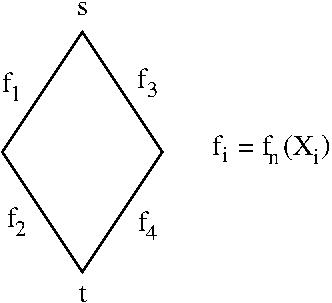
The function he considered is an iterated AND-OR function $f_n(X)$ of $n=4^h$ variables, and is defined inductively as follows. For $n=4$, \[ f_4(x_1,x_2,x_3,x_4)=x_1x_2\lor x_3x_4. \]

Theorem (Tkachov 1980): Every monotone $\Sigma_3$-circuit for $f_n$ has $2^{\Omega( n^{1/4})}$ gates.We will sketch his argument when translated into "modern" terms, used in the book. Roughly speaking, his argument is as follows:
On the other hand, every $\pi$-scheme (i.e. DeMorgan formula) has the following easy verifiable properties, not shared by arbitrary contact schemes. A chain in a scheme is a path from its source to a sink. A cut of a set of chains is a set of contacts intersecting each of these paths; such a cut is minimal (is a min-cut) if no its proper subset does the job. A global cut is a min-cut of all paths in the scheme. Then we have:
Now suppose we have a monotone $\Sigma_3$-circuit computing $f_n$. This circuit is just an OR of monotone CNFs. Every minterm of $f_n$ must be produced by at least one of these CNFs. So, take one of these CNFs $F$. Minterms of $f_n$ correspond to chains, and maxterms of $f_n$ to global cuts in the $\pi$-scheme for $f_n$. Let $P$ be the set of minterms of $f_n$ produced by $F$, and $P^{\perp}$ denote the set of all min-cuts of $P$. Let $|F|$ be the number of clauses in $F$. Lemma 2 in his paper states the following.
Lemma A: $|F|\geq |P^{\perp}|$.Proof: It is enough to show that every min-cut $Y$ of $P$ lies in at least one clause of $F$, and that no two min-cuts can lie in the same clause. By (ii), we know that $Y\subseteq X$ for some maxterm $X$ of $f_n$. On the other hand, there must be at least one clause $C$ of $F$ such that $C\subseteq X$. To see this, take an assignment $a\in \{0,1\}^N$ defined by: $a_i=0$ if $i\in X$, and $a_i=1$ otherwise. Then $F(a)\leq f_n(a)=0$ since $X$ is a maxterm of $f_n$. Had we however $C\not\subseteq X$ for all clauses $C$ of $F$, then $a$ would set to $1$ at least one variable in each clause, and we would get $F(a)=1$, a contradiction. Thus, both $Y$ and $C$ are contained in $X$. The clause $C$ is a cut of $P$. Hence, it contains some min-cut $Y'\subseteq C\subseteq X$ of $P$. Held now $Y\not\subseteq C$, then the maxterm $X$ would contain two two distinct min-cuts $Y$ and $Y'$ of the same set of minterms $P$, contradicting Property (i). We have thus shown that every min-cut $Y$ of $P$ must be contained in its own clause, as claimed. $\Box$
The main technical contribution of the paper is the following lemma, which is the Main Lemma in his paper. He gives its proof in the appendix. The proof itself uses a clever counting, but is too long to at least sketch it here.
Lemma B: For every subset $P$ of minterms of $f_n$, \[ |P^{\perp}| \gtrsim |P|\cdot 2^{n^{1/4}-\sqrt{n}}. \]Having this lemma, we can finish the proof of the theorem as follows. For the number $\mu_n$ of minterms of $f_n$, we have the following recursion (recall that $n$ is of the form $n=4^h$): $\mu_4=2$, and $\mu_{4n}=2\mu_n^2$. This yields $$\displaystyle \mu_n\geq 2^{\sum_{i=0}^{h-1}2^i}=2^{2^h-1}=2^{\sqrt{n}-1}. $$ Let $s$ be the top fanin of our circuit, i.e. the number of CNFs in it. Then there exists a CNF $F$, the family $P$ of minterms of $f_n$ produced by which is large enough: \[ |P|\geq \frac{1}{s}\cdot \mu_n\gtrsim \frac{1}{s}\cdot 2^{\sqrt{n}}. \] Lemmas A and B imply \[ |F|\geq |P^{\perp}|\gtrsim |P|\cdot 2^{n^{1/4}-\sqrt{n}} \gtrsim \frac{1}{s}\cdot 2^{\sqrt{n}}\cdot 2^{n^{1/4}-\sqrt{n}} = \frac{1}{s}\cdot 2^{n^{1/4}} \] Thus, $\max\{s, |F|\}=2^{\Omega( n^{1/4})}$. $\Box$
Note (observed by Igor Sergeev): Recall that the function $f_n$ is defined as a read-once formula having the form of alternating AND and OR gates (see how it looks). In 1984, Valiant has shown that the majority function $Maj_m$ of $n$ variables can be computed by an alternating (not read-once) AND/OR tree of depth $5.3\log m$. Thus, $Maj_m$ is a "subfunction" of $f_n$ for $n$ about $m^{5.3}$ which can be obtained from $f_n$ by setting some variables to constants, and identifying some of the remaining variables.
Acknowledgment:
My thanks to Igor Sergeev for scanning and repairing
this (old, hardly available, and "scan-resistant")
paper, and
for very interesting discussions on the paper itself.
Reference:
April 2013